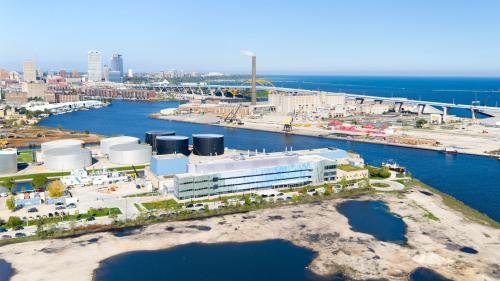Regular readers of Brookings research know that improving regional economic competitiveness is not easy, requires coordinated, collaborative, and aligned efforts across multiple sectors, and can’t be solved overnight with one miracle project.
But what if there was one tool civic leaders had at their disposal that could significantly improve business competitiveness, raise living standards for workers, ease fiscal burdens on government, and enhance environmental quality?
Over the last few months, the Fund for Our Economic Future (a philanthropic alliance devoted to improving the economy), transportation planning organizations, and business development entities in Northeast Ohio have jointly developed data and mapping that can be used by enlightened public officials and civic leaders of all stripes as a starting point to identify where we should prioritize business expansion, public transportation, workforce services, and other community assets. These “job hubs” are contiguous places that have high concentrations of employers working in the traded sectors (industries that sell their goods and services outside the local market) that we know to be the bedrock of economic growth.
Why is this so significant? To understand the potential impact, one needs to understand the development patterns of Northeast Ohio, which are not unlike what’s occurred in other mid-sized cities in the New American Heartland, the region that expands between the Rocky Mountains and the Appalachians.
Over the last several decades, development in Northeast Ohio has been characterized by uncoordinated, outward physical expansion that is not supported by underlying population or economic growth. In 1948, for example, Cuyahoga County’s population stood at about 1.4 million. In 2002, the population was relatively unchanged (and today it’s slightly less at 1.25 million), yet nearly all of the county’s land had been developed. Development consumed Cuyahoga County in just 50 years; today, fewer people use more than twice as much land. A similar story has played out in other areas of Northeast Ohio.
That all adds up to a lot of new roads, sewers, power lines, traffic lights, and bridges to serve a declining base. This no-growth sprawl results in longer and more costly commutes for residents, diminishing air quality from those longer commutes, a shrinking talent pool of reliable on-time workers for employers, entire low-income populations cut off from economic opportunity, and highly-strained municipal budgets.
How did this happen? The issue is not bad or incompetent people—we have some of the strongest civic and business leaders in the country—nor is it free market forces. To the contrary, we’ve subsidized and exacerbated these trends. Political fragmentation, dispersed decisionmaking, and lack of alignment yield collectively nonstrategic and civically bad outcomes. Unlike communities in America’s south and west, Northeast Ohio has hundreds of units of government each trying to serve their constituencies the best they can. They know that cooperation will be useful, but that is tough to pull off in a resource-constrained world.
Moreover, decisions about where a business should grow involve many civic sectors, including business development entities, workforce organizations, transportation planners, public transit, and public sector entities at the local, county and state level—making tactical decisions within the context of their own long-range plans. As a result, we are left in a perpetual loop of reactive decisionmaking, widespread expansion, sub-optimal investments, and reduced economic competitiveness.
This is where job hubs come in. Already, much of the economic development world has embraced the idea of transit-oriented development (TOD). But in practical terms, TOD is typically oriented around one or a handful of sites promoting commercial and tech-based development in the urban core. What if the TOD mindset was applied to an entire region? A first pass at the data suggests that Northeast Ohio has a solid distribution of existing hubs throughout our region, with at least one in every county (see a preliminary map). These hubs represent roughly half of our traded-sector employment. There is additional potential in places that used to be a job hub and still have a great deal of in-place infrastructure and connectivity but have suffered from abandonment.
Now, leaders need to come together to identify and prioritize the most promising areas for growth—and then to do some “place-making” around them so they are globally competitive. Job hubs can exhibit the kind of density that makes non-automotive transportation a realistic option, allows for efficient investment in high-speed digital connections, and perhaps even opens the way for other amenities that are a magnet for talent, including hiking and biking trails, vibrant public spaces, eclectic restaurants and retail shops. In addition to public officials, business chambers, transportation planners, public transit, workforce intermediaries, neighborhood groups, and others need to be at the table.
I suspect many may think this is an obvious solution. But perhaps that is the beauty of it. I was recently perusing the annual report of a state-wide economic development organization and it featured photographs of the “best possible location” for business expansion. Both photos featured agricultural land requiring significant infrastructure investment, with no conceivable transit connections, and located far from available workforce. Collaboratively defined, prioritized, and enhanced job hubs can help crystallize opportunities in a way that works for everyone, and points the way to a more economically competitive and sustainable future.
Brad Whitehead is the president of the Fund for Our Economic Future in Cleveland, Ohio, a non-profit focused on strengthening and sustaining the Northeast Ohio regional economy. The Fund is also a long-time collaborator in Brookings Metro’s regional network and most recently has contributed to its inclusive economic growth work.
The Brookings Institution is committed to quality, independence, and impact.
We are supported by a diverse array of funders. In line with our values and policies, each Brookings publication represents the sole views of its author(s).






Commentary
Zeroing in on job hubs: How communities can improve their competitiveness
August 22, 2017